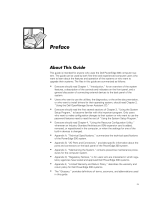
The memory subsystem also provides ECC capability, which corrects all single-bit memory errors and detects all
multibit errors.
Self-Monitoring Analysis and Reporting Technology (SMART) support, which warns you at system start-up if
the hard-disk drive has become unreliable. To take advantage of this technology, you must have a SMART-
compliant hard-disk drive in the computer.
The system's basic input/output system (BIOS), which resides in flash memory and can be upgraded remotely or
by diskette if required.
Plug and Play capability, which greatly simplifies the installation of expansion cards. Plug and Play support
included in the system BIOS allows you to install a Plug and Play expansion card without setting jumpers or
switches or performing other configuration tasks. The Resource Configuration Utility (RCU) allows you to
configure an existing ISA expansion card for conflict-free operation. Also, because the system BIOS is stored in
flash memory, it can be updated to support future enhancements to the Plug and Play standard.
NOTE: The Windows NT operating system does not provide ISA Plug and Play support. Therefore, some
ISA Plug and Play cards (such as modem, sound, and network cards) may not work with your Windows
NT operating system unless you configure them manually.
Universal Serial Bus (USB) capability, which simplifies connection of peripheral devices such as mice, printers,
and computer speakers. The USB connectors on the computer's back panel provide a single connection point for
multiple USB-compliant devices. USB-compliant devices can also be connected and disconnected while the
system is running.
CAUTION: Do not attach a USB device or a combination of USB devices that draw a
maximum current over 500 milliamperes (mA) per channel or +5 volts (V). Attaching devices
that exceed this threshold may cause the USB ports to shut down. See the documentation that
accompanied the USB devices for their maximum current ratings.
A modular computer chassis with a minimum number of screws for easy disassembly and improved
serviceability.
The system board includes the following integrated features:
Six 32-bit PCI expansion slots, including one that is a shared PCI (32-bit)/ISA (16-bit) expansion slot.
A high-speed, high-resolution ATI RAGE IIC accelerated graphics port (AGP) video controller with 2 MB of
synchronous graphics random-access memory (SGRAM). AGP greatly improves graphics performance by
providing a dedicated bus for a faster interface between the video subsystem and system memory. AGP also
allows conventional memory to be used for video-related tasks.
Integrated server management circuitry that monitors operation of the system fans as well as critical system
voltages and temperatures. The integrated server management circuitry works in conjunction with the HP
OpenView Network Node Manager Special Edition (NNM SE) and the Dell Hardware Instrumentation Package
(HIP) software.
A diskette drive interface, which supports a 3.5-inch diskette drive.
EIDE controller that supports an EIDE CD-ROM drive.
Small computer system interface (SCSI) support via an integrated Adaptec 7890 Ultra2/Wide low voltage
differential (LVD) channel, which provides support for high-performance SCSI hard-disk drives.
Two high-performance serial ports and one bidirectional parallel port for connecting external devices.
A Personal System/2 (PS/2)-style keyboard port and a PS/2-compatible mouse port.
The following software is included with your Dell system:
Video drivers for displaying many popular application programs in high-resolution modes. For more information
on these drivers, see Using the Dell OpenManage™ Server Assistant CD.
HP OpenView software, including OpenView Network Node Manager Special Edition (NNM SE) with Dell
OpenManage HIP, a standards-based management solution that provides concise and in-depth views of




















